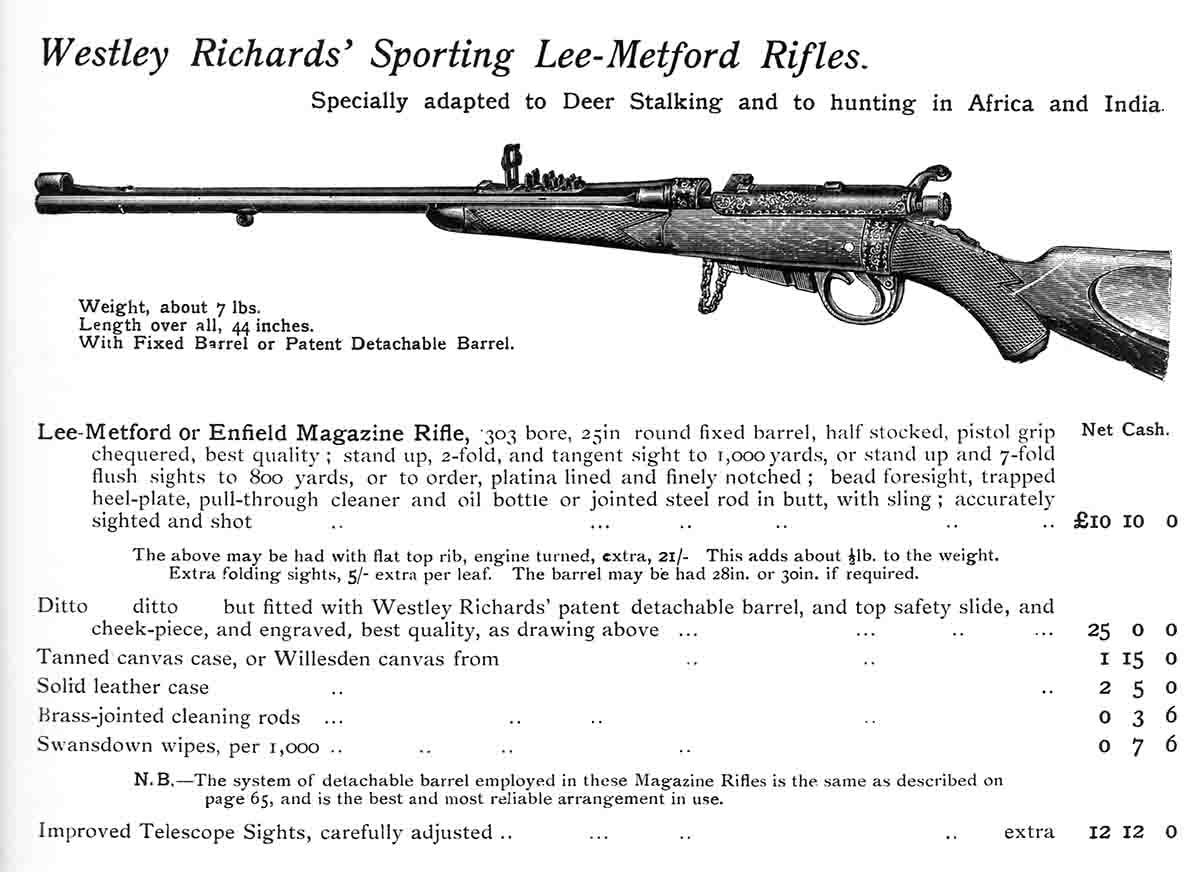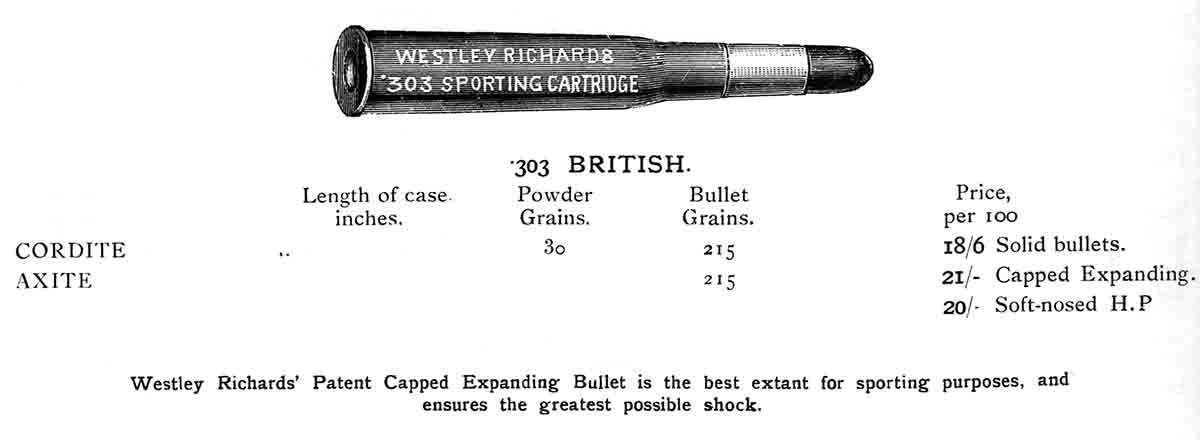the .303 British and Black Powder
feature By: John Rhodes | April, 19

When the cartridge was later loaded with smokeless powder, it didn’t take long to burn out the rifle’s lands, so they changed to the square Enfield design and we have Lee Enfields as they are known today. The challenge of finding a black powder load with acceptable accuracy beckoned to me.
When I first started shooting the No. 4 Mk I in 2007, I was using 200-grain, gas check, roundnose bullets from Lyman mould No. 314299, but accuracy was lacking. A year later I purchased a second rifle, a No. 1 Mk III.

The Lyman No. 314299 dropped bullets measuring .313 inch, which were too small for the bore of the No. 4 Mk I and were printing an average of 3.54 inches for six, three-shot groups using a load of 25 grains of IMR-3031. In the hopes of getting a mould that might drop a bullet to match the bore size, I purchased Lee mould No. C312-185-1R, 185-grain roundnose bullet. As luck would have it, the mould turned out to be oversized and fit perfectly. Shooting this bullet in the No. 4 Mk I, it printed an average of 2.33 inches for six, three-shot groups using the same 25-grain load of IMR-3031. After purchasing the No. 1 Mk III, I found it preferred the Lyman No. 314299, 200-grain bullet. That rifle would print an average of 2.34 inches for six, three-shot groups using 25 grains of IMR-4895. The point here is each of the rifles with the correct bullet combination would produce good accuracy. I needed to know this before I tried black powder. The bullet dimensions are listed as follows: Lyman 314299, 200-grains, .303-inch bore-ride section, .313-inch driving band section; Lee C312-185-1R, 185-grains, .3035-inch bore-ride section, .315-inch driving band section.
The bullets used for shooting and reported in this feature were cast of wheel-weight alloy and heat-treated. They were not sized but left as cast. The bullets used in the smokeless powder loads were lubed with NECO’s Taurak T250, dusted with mica and dressed with a Hornady gas check. The bullets used in the black powder loads were also heat-treated and left as cast but they were lubed with Lyman’s Black Powder Gold, and also dressed with Hornady gas checks. I also used Serbia’s Prvi Partizan brass and CCI 200 Large Rifle primers.
The first trial using black powder took place in 2007 with the No. 4 Mk I. At that time, I used 51 grains of FFFg GOEX powder. It completely filled the case, leaving just enough room for the bullet to be seated with the gas check at the cartridge shoulder. There wasn’t much compression; I’m guessing about 1⁄8 inch. I ended up shooting most of the rounds on target, ending up with two, three-shot groups, one being 3 inches and the last, 5½ inches. I wasn’t happy with this shooting and spent many hours contemplating what I could do to get better accuracy.
Going back to that written statement I had read, “The cartridge’s original load was 70 grains of fine-grained black powder” kept returning and I couldn’t help wondering if what they meant by “fine-grained” was something much finer than FFFg powder. If this was the case, then why couldn’t I use FFFFg flintlock priming powder? I didn’t want to overly compress the powder, so I didn’t try to force 70 grains in the case. Fifty-nine grains fit well with minimal compression; just enough to seat the bullet such that the gas check didn’t extend below the bottom of the case neck. Actually, 60 grains would have fit but I stopped at 59 grains, only to keep the amount of compression to a minimum or at about the same as that used with the FFFg loads. I haven’t read anything where black powder cartridge shooters have used FFFFg powder and that is to be expected, since it is flintlock priming powder. I don’t recommend this, but my reasoning for trying it was that smokeless powder is never used in muzzleloaders because they can’t withstand the pressure generated. Modern steel barrels on smokeless powder bolt-action rifles that can withstand smokeless loads would also be capable of withstanding the pressure generated by black powder. So, the question remains, should FFFFg priming powder be used in a modern cartridge? There probably isn’t a book written that would so much as comment on this, but my thinking was that any medium-sized cartridge would take the pressure of the load, otherwise the original .303 cartridge wouldn’t have been able to be loaded as it was. I don’t recommend FFFFg for any cartridges, especially large-capacity cartridges. This is strictly what I did in my rifle and not all rifles are the same.

While shooting the three-shot group test loads in the No. 4 Mk I, I ran two wet patches and two dry patches through the bore after each three-shot group. The first three shots formed a group of 4¾ inches and didn’t get my hopes up. Granted, the following two groups got smaller, but the next groups opened to over 6 inches. At the time, I thought this could be due to my sight picture or fouling. The morning was passing and the wind was picking up, so I fired one shot in the No. 1 Mk III and wished I hadn’t when it came time to clean it.
When I took the rifles home and started cleaning the No. 4 Mk I, it wasn’t cleaning up as easily as it did when I used the 51-grain charges of FFFg black powder. I was very happy I only fired one round through the No. 1 Mk III because as it was, it took six hours to clean both rifles. This became an exercise of deep cleaning. I didn’t count the number of patches used, but I started with soap and water, and then switched to the green Three Rivers Black Powder Solvent. This stuff is good but it didn’t appear to touch the fouling. I then ran steel wool through the bore and followed that with Hoppe’s No. 9 solvent. Granted, that’s not a black powder solvent, but while using it, a nylon brush was used, followed by more patches. I still wasn’t happy, so I ended up with J-B Bore Cleaner followed by more patches. By comparison, I can clean one of my muzzleloaders in an hour.
In my opinion, I believe the Lee 185-grain bullet doesn’t hold enough lube for black powder shooting. The FFFFg black powder fouling most likely caked and hardened in the bore, and if more lube could be used, it would help keep the fouling softer. This brings up a problem of case capacity. The only way more lube could be added would be to add a grease cookie just under the bullet, the same as when paper patch bullets are used. Doing this would require the bullet to be seated out farther or reducing the powder charge to make room for the grease cookie. Even though I was running two wet and two dry patches through the bore after every three-shot group, I believe the FFFFg powder was fouling the bore and therefore produced the last three, six-inch and larger groups. The fouling was also being baked onto the bore, possibly due to a combination of the fine powder burning at a hotter temperature and the square Lee Enfield lands.

.jpg)


